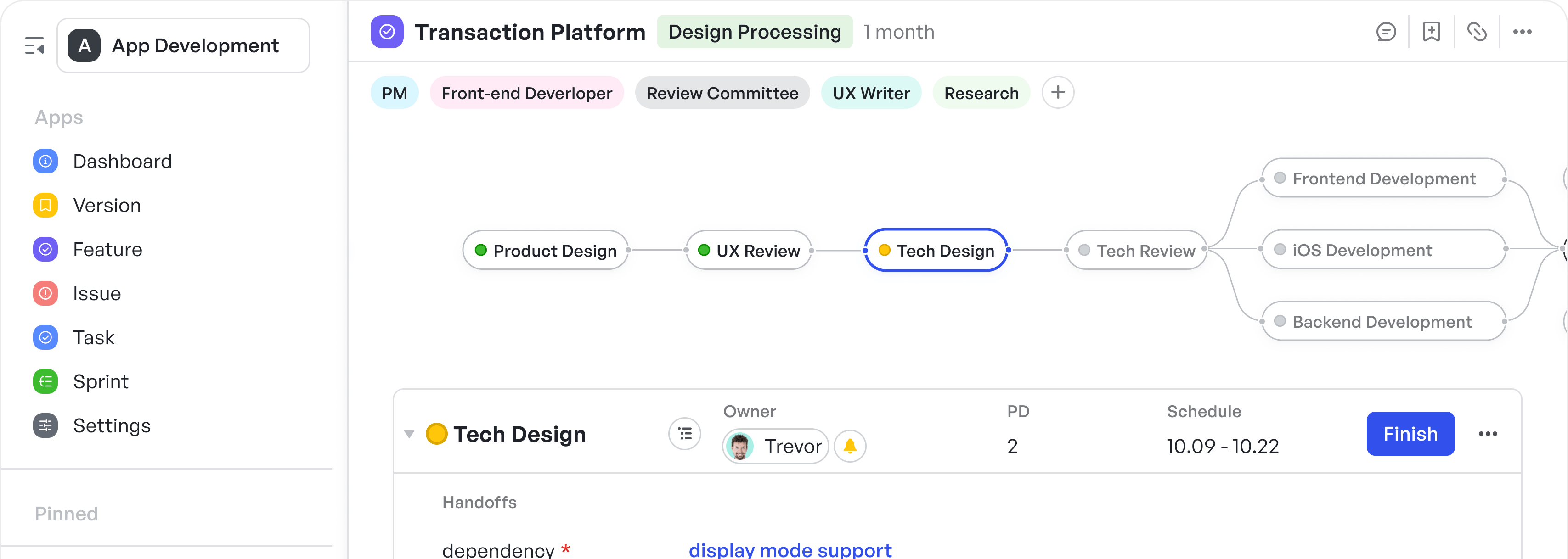"Failing to plan is planning to fail." Alan Lakein’s quote sums up just how crucial planning is in project management.
In Agile, fixed dates and scopes are often seen as limitations. However, many organizations still rely on them to guide their projects, and we can't ignore their importance.
Even when we move away from rigid timelines and scopes, planning remains crucial. In product development, for example, customers typically won’t commit to a budget without a precise delivery date and price. They want specifics, and that’s where agile planning comes in.
So, how do you create an Agile project plan? It's a tricky question, and many resources focus only on software development. This can make Agile seem like it’s only for the tech industry, but that's not the case. Agile principles can be adapted to many types of projects, not just software.
In fact, McKinsey & Co. Research reveals that than non-Agile teams. Additionally, 73% report improved employee engagement, and 93% see better operational performance.
In this guide, we’ll walk you through the Agile planning process. By the end, you’ll have a clear, step-by-step plan for your organization to follow.
What Is Agile Planning?
250px|700px|reset
加载中,请稍后
Agile planning is part of the Agile methodology, a flexible project management approach focusing on adaptability and iterative progress.
Unlike traditional methods that rely on detailed, fixed plans, Agile planning evolves continuously. It welcomes changes and incorporates regular feedback from end users throughout the project. This approach keeps teams responsive and aligned with user needs.
In Agile planning, projects are broken down into smaller, actionable tasks to ensure clarity and focus. The process involves creating a clear vision for the project by breaking down tasks and determining how to accomplish them. Here are some key components of Agile planning:
- Roadmaps: These provide a high-level guide for the product’s release schedule and direction.
- Sprints: Teams focus on specific groups of tasks within a set time frame, promoting incremental progress.
- Feedback Plans: Frequent user feedback helps teams adjust strategies quickly and remain flexible to change.
- User Stories: These are task descriptions written from the end user's perspective, focusing on how users will benefit.
Agile teams use user stories to decide what features or functionalities to work on during each phase. This perspective helps prioritize tasks, ensuring teams deliver maximum customer value early and often.
By focusing on user needs, Agile planning supports the development of meaningful, customer-centric solutions.
Why Is Agile Planning Important?
With growing user demands and increasingly complex projects, agile planning simplifies development cycles and maximizes efficiency.
This approach offers numerous advantages that address modern project challenges while keeping teams adaptable and user-focused, including:
- Enhanced usability: Gathering feedback from users and stakeholders ensures the final product aligns with real-world needs.
- Incremental progress: Dividing projects into smaller, manageable chunks allows for early delivery of high-priority features. Faster feedback loops help teams refine features effectively.
- Room for improvement: Teams regularly evaluate their processes to boost productivity, improve quality, and enhance overall effectiveness.
- Adaptability: Agile encourages adapting plans based on shifting priorities, evolving requirements, and changing market trends.
Agile Project Planning vs. Traditional Project Planning
In the past, organizations relied heavily on long-term, detailed project plans to achieve their goals. This worked well in stable markets where change was minimal and precision was critical.
However, as markets grew more dynamic, businesses needed a planning approach that embraced flexibility and adaptability. That’s where Agile project planning gained prominence.
250px|700px|reset
加载中,请稍后
Unlike traditional Waterfall planning, which follows a structured and linear approach, Agile uses an iterative method that adjusts quickly to changing needs. Agile planning thrives in environments where user requirements evolve and frequent updates are necessary.
Both approaches have their advantages depending on the project type. Traditional planning works best for projects like construction, where fixed steps and detailed instructions are necessary. On the other hand, Agile is ideal for knowledge-based work, offering the flexibility to revise plans at any point.
With Agile, teams focus on short-term objectives, creating room for continuous improvements as the project progresses.
Agile Planning Is NOT Scrum Planning
You might come across claims that Agile planning is identical to Scrum planning, but this isn’t the case. While Scrum is widely used in software development, it offers a specific and structured framework for planning. However, its prescriptive nature has drawn criticism, even among its users.
Unlike Scrum, Agile planning extends beyond software development to apply across industries and business types. Agile is not about following one fixed method; it emphasizes versatile strategies that adapt to diverse needs. This makes Agile a broader concept, focusing on general principles that can effectively support various industries.
Rather than dwelling on the flaws of Scrum, it’s more productive to explore how Agile thinking fits into different industries. Agile provides tools and techniques that work well company-wide, regardless of the business type or scale.
The 6 Levels of Agile Planning
The "Agile Planning Onion" is a valuable model for understanding the layers of Agile planning. It captures how planning spans from broad organizational goals to daily tasks.
Let’s break it down step by step.
- Strategic planning
- Strategic planning
This level focuses on the organization’s overall vision and long-term objectives. Senior leadership defines how to achieve these goals, setting a clear direction for everyone.
For instance, a retail company may aim to increase revenue by 20% through a new digital strategy. This initiative would guide decisions over the next two years, ensuring efforts align with corporate growth targets.
- Portfolio planning
- Portfolio planning
Portfolio planning connects strategic goals with specific products or services. Senior managers or department heads oversee this process, aligning initiatives with the broader strategy.
To support the digital strategy, teams might propose a faster, more engaging purchasing process. For example, a digital team could add a mobile app to the company’s portfolio, enhancing the customer experience at home.
- Product planning
- Product planning
At this level, teams create a roadmap for how a product will evolve over time. Product managers, project managers, and researchers collaborate to define medium-term priorities and the resources needed.
For a mobile app, this might involve prioritizing features like user-friendly navigation or personalized recommendations. Teams would estimate the effort required for each feature and decide which ones to develop over the next year.
- Release planning
- Release planning
Release planning organizes how and when product updates or new features reach customers. Delivery managers and technical leads outline the steps needed to launch changes effectively.
The development team might plan bi-monthly releases, starting with the app's core features. They also create frameworks to integrate future updates seamlessly, ensuring ongoing improvements.
- Iteration planning
- Iteration planning
This phase focuses on short-term goals, breaking work into manageable sprints. Teams of developers, designers, and testers plan one to four-week iterations, ensuring consistent progress.
For the app’s initial release, features from the product roadmap could be divided into two-week sprints. Teams regularly meet to review progress and adjust plans as necessary, keeping the project on track.
- Daily planning
- Daily planning
Daily planning keeps the team synchronized, addressing immediate tasks and obstacles. Team members discuss what’s done, what’s next, and any challenges they face.
In daily standups, everyone shares updates on their work. These meetings ensure clear communication and allow the project manager or Scrum Master to address roadblocks quickly, maintaining momentum.
Agile planning touches all levels, from strategic goals to daily workflows. It fosters adaptability and ensures alignment between long-term objectives and short-term execution. Teams refine their plans continuously, making it easier to adjust to changes and stay on course. Agile supports true business agility by planning at the right time and adapting as needed.
Key Characteristics of Agile Planning
Agile planning involves several essential traits, ensuring flexibility and alignment with project goals. Here are some of these characteristics, with practical insights to explain each concept.
- Prioritizing customer value
- Prioritizing customer value
Every Agile plan begins with a sharp focus on what the customer values most. This value should guide every decision, emphasizing outcomes over activities. Instead of tracking individual tasks, deliver measurable results that align with customer needs.
For example, a project might aim to streamline an online shopping experience, focusing on faster checkout processes. The plan directly connects with what customers find valuable by addressing this need.
- Delaying details for flexibility
- Delaying details for flexibility
Agile planning avoids locking in specifics too early, favoring adaptability as the project evolves. Think of it as preparing for a journey with unknown variables. You might estimate overall needs, but adjust the specifics as new information comes to light.
This flexibility ensures the team can effectively respond to changes, such as adjusting feature priorities after analyzing new user behavior data.
- Delivering in small batches
- Delivering in small batches
Breaking a project into smaller, manageable pieces allows frequent deliveries and quicker feedback. This method lets customers preview progress and refine their expectations early in the process.
For instance, a team developing a new app feature might release a basic version first. Feedback on this version helps refine the next iteration, saving time and resources.
- Using date ranges for timelines
- Using date ranges for timelines
Instead of promising fixed completion dates, Agile planning uses ranges for better accuracy. These ranges, informed by historical data, help manage customer expectations realistically.
For example, instead of committing to a July 1st release, the team might promise delivery between July 1st and July 10th. This approach accounts for uncertainties while maintaining accountability.
- Focusing on team collaboration over individual work
- Focusing on team collaboration over individual work
Agile planning focuses on the flow of work rather than assigning tasks to individuals early. This approach values self-organizing teams that adapt to project needs without unnecessary pressure on individual utilization.
If a dependency stalls one team, addressing it becomes a priority to maintain overall project momentum. This collaborative mindset ensures progress without inefficiencies.
- Building quality into the process
- Building quality into the process
Quality assurance in Agile isn’t an isolated phase; it’s integrated throughout the project lifecycle. Every step emphasizes maintaining quality, preventing issues from piling up at the end.
For example, a software team might use automated testing during development to catch bugs early. This practice ensures consistency in quality from start to finish.
- Focusing on initiatives, not tasks
- Focusing on initiatives, not tasks
Agile planning avoids micromanagement by concentrating on high-level goals or initiatives rather than individual tasks. Teams determine when to take on new work, enabling flexibility and better decision-making.
A team working on an e-commerce platform might plan a broader initiative like "enhance mobile responsiveness." As they progress, they decide on the specific technical steps needed.
- Making data-driven predictions
- Making data-driven predictions
Agile relies on historical data for forecasting, using statistical methods like Monte Carlo simulations to plan ahead. These tools provide probability-based outcomes, offering realistic insights into project timelines.
For instance, a forecast might predict an 85% likelihood of completing 150 features by October 15th. Such data helps set expectations and manage risks effectively.
- Maintaining continuous forecasting
- Maintaining continuous forecasting
Real-time updates are key to Agile planning, with tools offering continuous forecasts across projects. These updates ensure managers stay informed about project status without requiring granular oversight.
By connecting daily tasks to overarching goals, businesses can maintain visibility and adjust priorities. This system keeps all stakeholders aligned with the project's progress.
Agile Project Plan Example
Now that you know the basics of Agile planning, let’s see how it works in practice. Let’s consider a different scenario—developing a mobile app for fitness tracking. Here’s how to approach it.
Identifying major deliverables or features
To start, focus on identifying the key features the app needs. For example, the deliverables could include user registration, activity tracking, analytics dashboards, and integration with wearable devices.
Agile planning doesn’t require every detail upfront. Instead, it allows adjustments as the project evolves, saving time and adapting to changes.
250px|700px|reset
加载中,请稍后
Track the status of your project tasks using Meegle’s Taskboard
In Meegle, you can organize these features in a project timeline, laying out when and how they’ll be delivered. Features that don’t depend on each other can be developed in parallel, while dependent features follow a sequence.
Breaking down features into workable tasks
Once the features are outlined, the next step is breaking them down into actionable tasks. For instance, the "activity tracking" feature might include tasks like designing the UI, coding data capture, and testing functionality.
250px|700px|reset
加载中,请稍后
Fuel progress with the big picture of all the projects with Meegle
Visualizing these tasks on a work board, like a Kanban board, helps monitor progress and identify roadblocks. By linking this task board to the overall timeline, you get a clear view of how each task contributes to the larger goals.
This setup ensures everyone knows what’s happening, from which tasks are in progress to who’s responsible for each. It also makes collaboration easier, allowing the team to solve issues as they arise.
How to Leverage Meegle for Effortless Agile Planning
Agile planning requires an adaptive, iterative approach to ensure teams can swiftly respond to changing demands while delivering high-quality products.
Meegle, a versatile, agile development tool, simplifies this process across all six levels of agile planning: Strategy, Portfolio, Product, Release, Iteration/Sprint, and Daily.
At the strategic level, Meegle enables teams to define and align their long-term goals with actionable plans. The tool allows businesses to set clear objectives and KPIs, ensuring the team communicates the strategy effectively. This ensures that all efforts are aligned towards a common vision.
Meegle's portfolio management features streamline the tracking and prioritization of various projects. Teams can easily visualize their entire portfolio, assess resource allocation, and prioritize initiatives based on strategic goals and business value. This high-level overview helps managers make informed decisions about where to allocate resources for maximum impact.
Managing all these steps becomes seamless with Meegle’s Agile Development Template. This template empowers teams to manage projects flexibly, track iterative progress, and integrate feedback seamlessly. While Agile originated in software development, it has now become a go-to methodology for various industries due to its adaptability and focus on delivering value.
250px|700px|reset
加载中,请稍后
Manage their tasks efficiently using the Agile Development Template by Meegle
With this template, you can stay organized by tracking everything from epics and user stories to sprints and tasks, ensuring a smooth progression from ideation to release. The platform integrates easily with existing workflows, allowing seamless prioritization and refinement of the product backlog.
250px|700px|reset
加载中,请稍后
Organize product roadmap with epics, stories, versions & sprints
The platform also offers real-time metrics and progress insights, helping you stay aligned with your goals and ensuring no detail slips through the cracks.
Similarly, the node-driven workflow in Meegle is particularly effective at adapting to change. It lets teams map out tasks visually, breaking them into smaller, manageable nodes that are easy to track and connect. This approach enhances clarity, makes inefficiencies visible, and ensures the team can adjust quickly when priorities shift.
250px|700px|reset
加载中,请稍后
Visualize and optimize your tasks with Meegle
By simplifying the process and providing transparency, Meegle encourages teams to focus on the work that directly supports their project’s objectives. This aligns perfectly with Agile principles, which prioritize delivering value efficiently and iteratively.
Additionally, Meegle’s Kanban boards are a central feature, offering a clear overview of product backlogs and enabling seamless sprint planning. Teams can manage work in progress, limit bottlenecks, and quickly respond to changing priorities.
250px|700px|reset
加载中,请稍后
Manage your project with a Kanban board
For instance, during a two-week sprint, a team might move user stories across columns like "Backlog," "In Progress," and "Done," maintaining visibility and accountability throughout the process.
Meegle also boosts team alignment with workflow automation. It can notify team members about daily tasks, simplifying stand-ups and fostering a culture of efficiency. Let’s take a broader look at how automation helps with the agile planning process.
Automations to Seamlessly Implement Agile Planning Steps
Automation is also key in Agile planning, where reducing time spent on routine tasks means more time for meaningful work. Meegle’s automation features let teams set up recurring workflows, ensuring that essential processes continue to run smoothly without manual intervention.
250px|700px|reset
加载中,请稍后
Free up time by automating tasks at hand
For instance, if your team handles repetitive tasks during every sprint, Meegle can automate these processes, freeing up time to focus on innovation and high-value work. This supports Agile’s commitment to continuous improvement by streamlining daily operations.
Here’s how Meegle does this:
Triggers that act when you need them
Meegle’s triggers initiate workflows exactly when needed, based on specific events or changes. For instance, task creation, delays, or project schedule updates can automatically activate the right processes.
250px|700px|reset
加载中,请稍后
Set up automated notifications for custom triggers with Meegle
This precision ensures that no effort is wasted and workflows remain uninterrupted.
Conditions that sharpen automation
Automation is most effective when it targets the right tasks. Meegle lets you set detailed conditions, ensuring only relevant actions are automated.
250px|700px|reset
加载中,请稍后
Deliver the best results by defining filtering criteria
For instance, you can set notifications for features under a specific business line or summarize a list of unscheduled features. Conditions can also filter tasks involving a particular team or individual, ensuring clear visibility. Additionally, summarizing features relevant to the "frontend development" role can streamline communication for the frontend team.
This focus keeps your processes sharp, eliminating unnecessary steps and maintaining accuracy throughout the project management workflow.
Actions tailored to your workflow
Every action in Meegle’s automation can be customized to fit your team’s needs. Actions such as sending notifications, updating statuses, or organizing project nodes are designed to reduce manual effort.
250px|700px|reset
加载中,请稍后
Execute tasks under certain scenarios and conditions
These features help your team stay on track and achieve goals faster.
A treasury of ready-made templates for quick setup
Meegle offers nearly 20 pre-built templates to simplify even the most complex automations. With these tools, teams can implement ideas quickly without building workflows from scratch.
This allows for a faster transition from planning to execution, saving time and resources.
Automatic node rollback for error handling
If a project node fails a review, Meegle can automatically roll it back for re-evaluation. This ensures quality control while saving time on manual adjustments. By catching and addressing issues immediately, teams can maintain momentum and uphold high standards.
With Meegle, automation transforms routine processes into seamless, efficient workflows, empowering teams to focus on innovation and Agile success.
Advanced Reporting and Insights for Stronger Iterations
You can gain valuable insights into project performance by analyzing past project data with built-in metrics, customizable dashboards, and charts.
This ensures you can spot issues quickly and make the necessary adjustments for ongoing enhancement.
250px|700px|reset
加载中,请稍后
Monitor project status and identify areas of improvement
Apply these lessons to refine your workflows, making them more efficient and effective for future projects. This iterative process helps ensure that each project runs smoother than the last, driving continuous growth and improvement.
Planning for Better Agile Projects
Careful planning significantly boosts a project’s chances of running smoothly from start to finish. Challenges can arise, but projects structured around Agile principles handle setbacks more effectively. Agile planning focuses on adaptability, ensuring teams can address roadblocks without losing momentum.
Using a platform like Meegle simplifies Agile project planning by keeping your team aligned. Everyone stays organized, tracks their tasks, and works collaboratively toward shared objectives. This streamlined approach fosters teamwork while ensuring individual responsibilities are clear and manageable.
Ready to get started? Sign up to Meegle and manage projects the agile way!





